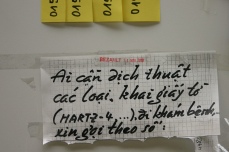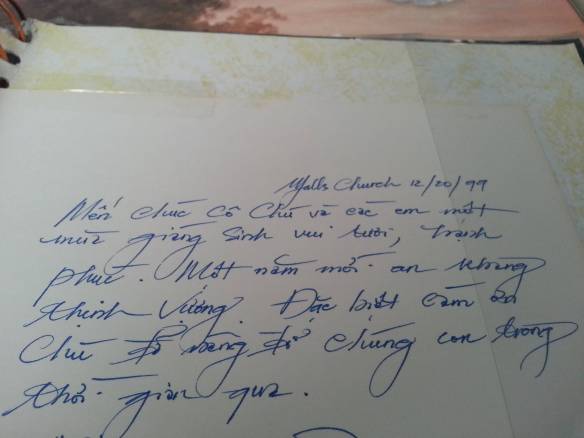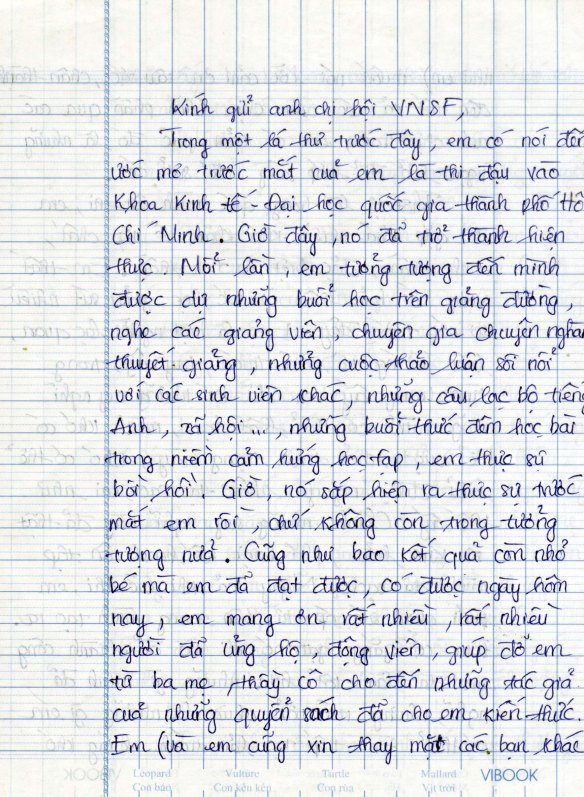 In just under four months of – ideally – daily practice, I’ve mastered some 300 Vietnamese words.
In just under four months of – ideally – daily practice, I’ve mastered some 300 Vietnamese words.
Or have I? When I see them on my flashcards, there’s a fair chance that I recognise them and can tell what they mean. But if you were to show me words that I haven’t studied, likely as not I would believe I recognised and understood many of those also. The trouble with Vietnamese is that so many of its words look so damn similar. The letter a alone has 18 varieties, counting all the possible single and double diacritics. But my European eyes will focus on the a as such and my European brain will remember only the bare and unadorned a. I have to force them to pay heed to the scribbles above it – and sometimes even below it, as in ạ, ặ and ậ.
However, this wasn’t going to be a lament, this post was to be about my next step in learning and about a tiny but neat discovery.
I’ve decided that just knowing what words mean is not good enough. I need to approach these flashcards differently: from their flip side. It’s all good and well knowing what ngày may means, but if I want to say ‘tomorrow’ and I only vaguely remember it’s a two-syllable word with two a’s in it, that won’t get me far, as there are literally thousands of those. So from now on, I intend to meticulously memorise every letter and every accent of the vocabs I study. I’m sure I’ll be failing most of the time, but I hope that this ambitious effort will make the more modest aim of merely recognising the words seem easy. Wish me luck.
So far I’ve been reading Vietnamese words from the page and from the screen, writing them by keyboard (not a mean feat!), hearing them as audiofiles and repeating them in my own voice as best I could. What I haven’t done much yet is write them by hand. I will correct that now, as I expect it to be a useful additional technique of imprinting the unfamiliar words on my reluctant brain. But Vietnamese writing presents fresh challenges, especially to someone with my abominable penmanship. Will I be at all able to write vowels with two superimposed accents, such as ẫ? What is an ẻ or ỉ even supposed to look like in handwriting? And as for ơ and ư – how exactly are they to be different from handwritten o and u?
Thank Google, the internet is rarely at a loss for words, even hand-written Vietnamese words – see examples below. It turns out that the hook-shaped accent on vowels such as ẻ and ỉ is written like a little dotless question mark on top. (Yes, I know that’s what it looks like in print. But print and handwriting are often quite different. Just think of our a’s and our g’s. And to prove my point, sometimes the same accent is written as a miniature 2 rather than a question mark.) The smaller hooks that grace the ơ and the ư are to rise up much higher than I would have guessed. So they are different from the printed form.
But the real surprise was in the double accents, the superimposed diacritics. The Vietnamese have solved the issue much more elegantly than I had expected. While the accents that change the value of the vowel are placed right above the letter (â, ă, ô, ơ, ư), those that indicate the tone may move to the right, ending up above adjacent letters or even above a space. So tiền (‘money’) may actually look like tiêǹ and số may become sô´. That makes a lot of sense, because these tone signs pertain to the whole syllable.
It’s none of my business of course, but my advice to the Vietnamese would be to adopt the same practice in printing. It would make the language look a lot more orderly and aesthetically pleasing.
(You can find the other blogposts about my adventures in Vietnamese here.)

This writer seems to relish in some of the diacritics. If I’m not mistaken, the words môt năm mới ‘a new year’ can be made out in the centre .


How’s your Vietnamese coming along?
I’m surprised that none of these articles mention conversation- are you talking to Vietnamese people? That’s the best way to practice…
I’m planning to learn Vietnamese at some point because I saw a TED talk one time where a guy said “Learning Vietnamese is much easier if you speak Mandarin and Cantonese.” So I was like … ok, that describes me…
LikeLike
Not so well, I’m afraid… I went through a particularly busy period and Vietnamese was among the things I had to drop.
You are right, talking to Vietnamese people would be an excellent idea. However, I feel that at the very beginning, that is just too frustrating for both sides. I was hoping I might get to that stage and then talk to the one Vietnamese person that I know, but it never happened. Oh well.
I’m pretty sure that if you speak a Chinese language, especially, a Southern Chinese language, Vietnamese should be pretty easy. The tones, the grammar and even the vocabulary show many similarities, I believe.
LikeLike
Well… wish you good luck! Especialy in Vietnam.
LikeLike
Fascinating stuff – I really enjoyed it! Reading the post, I wondered whether you had developed a particular strategy for learning new languages. There are so many different kinds of resource available (books, online courses, Duolingo, conversation exchanges on Skype etc.), it would be really interesting to know if you find any particular combination of these you find to be most effective?
LikeLike
Frankly no, that’s not something I have any special expertise in. I’m mostly using the Asimil book (which is in the case of Vietnamese is not available in English however), the Forvo audio files (forvo.com) and the Studyblue digital flashcards. I’ve also bought a few very simple Vietnamese children’s books and I may use Duolingo as an additional resource.
Returning to your question, I’m looking forward to the book that I mention at the end of my third blogpost on Vietnamese, by Alex Rawlings, which is about the strategy issue. But of course, there is a whole literature out there discussing it.
LikeLike
Another interesting source, once you get more proficient in the language, is this website that collects children’s stories: http://doctruyencotich.com/
In the tab TRUYỆN CỔ TÍCH THẾ GIỚI you even find Snow White and Cinderella!
LikeLike
Thank you, Lisa!
LikeLike